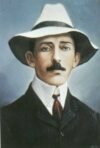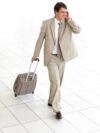How Air Force One Works
Air Force One is a prominent symbol of the United States in general and the office of the presidency in particular. Whenever the president travels overseas or across the country, he takes his high-tech deluxe jumbo jet with him. On September 11th, the president's plane showed that it was much more than an executive jet — it became a mobile bunker when all ground positions seemed vulnerable to attack.
In this edition of HowStuffWorks, we'll see what sets Air Force One apart from other planes, and we'll find out what it takes to send the president around the world. With all of the things that Air Force One carries, it's no wonder the media calls it the "flying White House."
Most people have a general idea that the president's plane is a flying office with all sorts of high-tech equipment. But there are two essential facts about Air Force One that the general public isn't aware of.
1. "Air Force One" isn't technically a plane: It's simply the radio call name for any U.S. Air Force plane carrying the president of the United States. As soon as the president steps aboard an Air Force plane, that plane is referred to as Air Force One by the crew and all air traffic controllers, in order to avoid confusion with any other planes in the area. If the president rides on an Army aircraft, that aircraft is Army One, and whenever he boards his specialized helicopter, that craft is Marine One. Civilians generally refer to the physical plane itself as Air Force One, of course, and we will in this article too.
2. Today, there are actually two planes that regularly fly under this designation — nearly identical Boeing 747-200B jets. The planes themselves are designated VC-25A, with tail numbers 28000 and 29000.

Photo courtesy U.S. Deparment of Defense
One of the two modified 747s that commonly flies
as "Air Force One"
The two planes have the same general structure as a normal Boeing 747-200B, and similar capabilities. They are almost as tall as a six story building, and they're as long as a city block. Each has four General Electric CF6-80C2B1 jet engines, which provide 56,700 pounds of thrust a piece. The top speed is between 630 and 700 miles per hour and the ceiling maximum (how high the plane can fly) is 45,100 feet. Each plane carries 53,611 gallons of fuel and weighs 833,000 pounds fully loaded for a long-range mission. With a full tank, the plane can fly half way around the world.
Like a normal 747, these planes have three levels. But the inside, the plane doesn't resemble commercial 747s in the slightest. In the next section, we'll look at the major components that set the VC-25A planes apart from a normal jetliner.
Air Force One has 4,000 square feet of interior floor space. Much of it looks more like a hotel or executive office than a jetliner, except for the seatbelts on all the chairs. The lowest level of the plane mostly serves as cargo space. Most of the passenger room is on the middle level, and the upper level is largely dedicated to communications equipment.
The president has onboard living quarters, with his own bedroom, bathroom, workout room and office space. Most of the furniture on the plane was hand-crafted by master carpenters.
The staff meets in a large conference room, which doubles as the president's dining room. Senior staff members have their own office area, and the rest of the president's staff also has space to work and relax. There is a separate area for reporters traveling with the president, and there is plenty of room for the flight crew to do their work. All in all, Air Force One can comfortably carry 70 passengers and 26 crew members.
The Hollywood Version
Air Force One got its Hollywood close-up in the 1997 Harrison Ford movie "Air Force One." While some of the details in the set are inspired by the real thing, the movie takes major artistic liberties. The Air Force says the real plane does not have an escape pod, as depicted in the movie, or even onboard parachutes. Of course, an escape pod could be one of the many special features the Air Force won't talk about.
Air Force One has a certain mythic, mysterious quality, largely because it is completely off limits to most of us. Even visiting politicians and journalists aren't allowed in some parts of the plane, and the Air Force is careful to conceal specific details of the craft's layout. A number of official and unofficial sources have published general descriptions of what's inside the plane, but nobody (as far as we know) has said how these pieces fit together.
Here at HowStuffWorks, curiosity got the best of us: We had to connect the dots. This illustration represents our best guess, based on the available information, of how the most famous jetliner in the world is put together.
Like an ordinary Boeing 747, Air Force One has three decks. The lowest deck holds luggage, food and classified equipment. The middle deck holds the bulk of the passengers. The upper deck consists of the cockpit and the communications area.
Passengers can enter through three doors. Two doors, one at the front of the plane and one at the rear, open onto the lower deck, and one door at the front of the plane opens onto the middle deck. Normally, when you see the president in the news getting on and off Air Force One with a wave, he is using the door onto the middle deck and a rolling staircase has been pulled up to the plane. Journalists normally enter through the rear door, where they immediately climb a staircase to the middle deck. Most of the press area looks something like the first class section of an ordinary jetliner, with comfortable, spaced out seats.
The crew generally enters through the lower door at the front of the plane. From here, they can proceed to the cargo area or climb a staircase to the middle deck.
The staff area is in the front section of the plane, on the middle deck. The galley and conference room/dining room are to the right. The conference room is one of the biggest rooms in the plane — it's almost as wide as the plane. A narrow passageway leads to a work area and the rear passenger compartment.
The president's suite and office is to the left of the entrance, on the middle deck, at the front of the plane. A stairway near the middle deck entrance leads to a landing area on the top deck. The flight crew walks straight from the stairway to the communications room, lounge and cockpit.
Logically, the plane should also have space for the service crew to ride and sleep, and it probably has more press and staff seating than we've shown here. In addition, it may have more office space and rooms for classified electronics. These extra areas could be on both the middle deck and the lower deck.
Along with its unconventional passenger space, Air Force One has a lot of technology that sets it apart from a normal jetliner. In the next section, we'll find out about these special modifications.
Because Air Force One carries the president, and because some trips can be quite long, the plane has a number of special features, many of which are found on no commercial airliner.
The crew prepares meals in two fully-equipped galleys. They store a large amount of food in freezers in the lower sections of the plane. The crew is equipped to feed about 100 people at a time, and the storage area holds as many as 2,000 meals.
The plane has a lot of technology in its onboard medical facility. The medical room has an extensive pharmacy, loads of emergency room equipment and even a fold-out operating table. The plane also has a staff doctor, who travels with the president wherever he goes. On every mission, the plane is prepared for a wide range of potential emergencies.
Unlike a normal 747, the plane has its own retractable stairways, for the rear entrance and the front entrance. These stairways open onto the lower deck, and crew members and staff climb internal staircases to get to the upper decks. The plane also has its own baggage-loader. With these additions, the plane never has to depend on an airport's facilities, which could be a security risk.
The most remarkable feature on the plane is it's extensive electronics. It has 85 onboard telephones, a collection of two-way radios, fax machines and computer connections. It also has 19 televisions and assorted office equipment. The phone system is set up for normal air to ground connections and secure lines. The president and his staff can reach just about anybody in the world while cruising tens of thousands of feet in the air.
The onboard electronics include about 238 miles of wiring (twice the amount you'd find in a normal 747). Heavy shielding is tough enough to protect the wiring and crucial electronics from the electromagnetic pulse associated with a nuclear blast.
Another special addition is the in-flight refueling connection. As with the B-2 and other combat craft, in-flight refueling gives Air Force One the ability to stay up in the air indefinitely, which could be crucial in an emergency situation.
Some of the most interesting parts of the plane — it's advanced avionics and defenses — are classified. But the Air Force asserts the two planes are definitely military aircraft, designed to withstand an air attack. Among other things, the plane is outfitted with electronic counter measures (ECM) to jam enemy radar. The plane can also eject flares to throw heat-seeking missiles off course.
Every Air Force One flight is classified as a military operation, and it is handled as such. Air Force crews at Andrews Air Force Base in Maryland carefully inspect the plane, and the runway, before every flight.

Photo courtesy U.S. Department of Defense
The maintenance and support complex for Air Force One, at Andrews Air Force Base in Maryland
When it's time to head off, the Marine One helicopter brings the president from the White House to Andrews Air Force Base. Teams all over the base keep an eye out for any unauthorized craft in the area and are authorized to shoot on sight.
In advance of every Air Force One flight, the Air Force crew sends C141 Starlifter cargo carrier planes, toting the president's motorcade, to the destination. This collection of bulletproof limousines and vans, loaded with weaponry, keeps the president safe on the ground.

Photo courtesy U.S. Air Force
C141 Starlifters deliver the president's motorcade in advance of Air Force One's arrival.
The president always arrives at the base with "the football," the briefcase that holds the codes for nuclear deployment. An Air Force officer guards the football for the entire flight, before passing it off to an Army officer on the ground.
Just like a normal jetliner, Air Force One has a crew to fly the plane and a steward crew to prepare and serve meals and to clean the aircraft. These crew members are carefully screened military personnel, with exemplary service histories. Even the crew members who prepare meals must operate with a high level of security. For example, when buying food, they must hit the stores undercover, and they must select markets at random, in order to protect the president from a poison attack. Onboard the plane, the crew provides 24-hour first class service.
These crew members enjoy a very rare privilege — they get to work alongside the president when he is at his most relaxed. Every president since Harry Truman has formed close connections with his flight crew, and the final Air Force One flight is always an emotional trip.
Up until World War II, the president of the United States rarely traveled far from home. Visiting other countries simply took too long, and it cut the president off from the major institutions of government.
The rise of air travel made it feasible for the president to move around the globe and return home in short order. In 1943, Franklin Roosevelt became the first acting president to take to the air when he rode a Boeing 314 "flying boat" to a wartime conference in Casablanca.
Roosevelt took the plane because German U-Boats made the seas too treacherous, but the success of the mission established air travel as the standard mode of presidential transportation. Soon, the government decided to assign a military aircraft for presidential use. The Air Force originally selected a C-87A Liberator Express, basically a B-24 bomber configured for civilian operation, which was christened the "Guess Where To."
After another C-87A crashed under mysterious circumstances, the Secret Service decided it wasn't a safe plane for the president. They soon configured a C-54 Skymaster for Roosevelt, complete with sleeping quarters, a radio telephone and a retractable elevator for Roosevelt's wheelchair. The plane, nicknamed the "Sacred Cow," carried Roosevelt on several important missions, including the historic Yalta Conference.

Photo courtesy National Archives and Records Administration
Harry Truman arriving in Berlin on the "Sacred Cow" in 1945
President Truman took over the Sacred Cow, and later replaced it with a modified DC-6, which he dubbed the "Independence." Unlike the Sacred Cow, the Independence was covered in patriotic decoration, including an eagle head painted on its nose. President Eisenhower introduced two similar propeller planes, with upgraded equipment, including an air-to-ground telephone and an air-to-ground teletype machine.
In 1958, presidential travel took a giant leap forward when the Air Force introduced two Boeing 707 jets into the fleet. The Air Force began using the radio call designation "Air Force One" during Eisenhower's administration, and the public took it up after Kennedy took office.
At the beginning of his term, Kennedy added a more advanced, long-range 707, and oversaw an aesthetic redesign — the blue and white decoration still used today.

Photo courtesy U.S. Deparment of Defense
The VC-137C, one of the Boeing 707s that predated the current Air Force One
This plane and a twin added to the fleet in 1972 played a part in some of the most important historical events of the past 50 years. The 707 flew Kennedy to Dallas on November 22, 1963, and brought his body back later that day. On the return flight, Lyndon Johnson was sworn in as the next president. The twin plane flew President Nixon from D.C. to California following his resignation. Mid-flight, the crew received confirmation that Gerald Ford had been sworn in as the next president, and they changed their radio call name from Air Force One to SAM (special air mission) 27000.
The twin 707s served President Reagan throughout his two terms, and George Bush Sr. through the first part of his term. In 1990, the Air Force replaced the planes with the 747s in use today. The planes may be replaced again as early as 2010, when they hit their 20-year mark.















